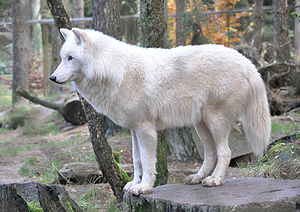Arctic wolf
| Arctic wolf | ||||||||||||
|---|---|---|---|---|---|---|---|---|---|---|---|---|

Arctic wolf ( Canis lupus arctos ) |
||||||||||||
| Systematics | ||||||||||||
|
||||||||||||
| Scientific name | ||||||||||||
| Canis lupus arctos | ||||||||||||
| Pocock , 1935 |
The arctic wolf , white wolf or arctic wolf ( Canis lupus arctos ) is a subspecies of the wolf ( Canis lupus ) and belongs to the dog family (Canidae). Since he lives in a very inhospitable and inhospitable area ( polar region ), his life is largely unexplored.
features
Arctic wolves have special adaptive characteristics that distinguish them from other subspecies of the wolf. Their particularly soft, dense and long-haired fur is almost white, dirty white to creamy white (slightly darker on the back) with individual gray and black hairs in habitats with permanent snow. In skins from more southern areas, the hair is grayish or yellowish, sometimes blue with clear black markings. The belly is white. The ears are smaller and rounded, and at low temperatures (down to −50 ° C) they are better protected from chilling. The muzzle is also slightly shorter and the legs are noticeably short. In terms of body shape, they are a bit more compact and weigh around 50 to 80 kg. The height is about 65 to 80 cm. The females are smaller and lighter. The body length is about 90 to 150 cm from the head to the tip of the tail.
Arctic wolves become sexually mature at two to three years of age. They usually give birth to five to six puppies. The average lifespan is about seven years.
Occurrence
Arctic wolves live on the Canadian Arctic Islands , from Melville Island to Ellesmere Island , on the north and east coasts of Greenland north of the 68th parallel, but not on permanent ice floes. The environment there is extremely harsh, the winters are long and dark.
behavior
The solidarity in an arctic wolf pack is even more pronounced than in packs of other subspecies of the wolf. A single arctic wolf could not survive long in the harsh climate. A pack consists of seven to ten, sometimes up to 30 animals.
nutrition
The arctic wolves' hunting area mostly extends over 1300 to 1600 km². They travel around 30 km a day to search for food. They hunt and eat almost anything they can spot, from voles , mountain hares, and lemmings to reindeer and musk ox . Occasionally they also succeed in catching birds . In order to be able to kill larger animals, they usually hunt cooperatively in packs. The population density, and thus the survival of the puppies, depends heavily on the food available.
Danger
The range of the arctic wolf is relatively safe from human activities because of the very inhospitable climate, whether it is hunting or the destruction of its habitat. However, he was shot by workers from the Arctic bases. Arctic wolves are now being hunted in harmless numbers by the Eskimos who sell the wolf skins .
literature
- Jim Brandenburg: The white wolf. Tecklenborg, Steinfurt 1998, ISBN 3-92404-439-2 .
- Jim Brandenburg: White Wolf. Tecklenborg, Steinfurt 1998, ISBN 3-92404-439-2 .
- Lucyan David Mech, Monika Thaler: The white wolf. Frederking & Thaler, Munich 2000, ISBN 3-89405-093-4 .
- Lucyan David Mech, Monika Thaler: On the trail of the wolves. Frederking & Thaler, Munich 1992, ISBN 3-89405-315-1 .



